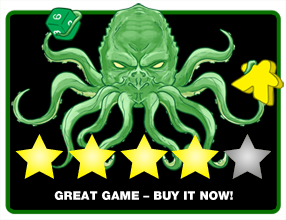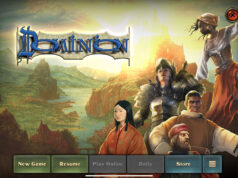 Despite being a reviewer of board games for over a year now, there is still one genre that I have not invested many of my gaming hours in. That would be tactical war games. I have played Memoir ‘44 but never played some of the more complex and hardcore games like Advance Squad Leader or Combat Commander. I recently caught word of a new iOS game being released by Shenandoah Studios, publishers of the award-winning Battle of the Bulge iOS game. The new game, Drive on Moscow, allows players to be either the Soviet or Axis forces during 1941 when the Axis army attempted to overtake Moscow. Is this game good for the uninitiated like myself or should it be kept in the hands of professionals? Read on.
Despite being a reviewer of board games for over a year now, there is still one genre that I have not invested many of my gaming hours in. That would be tactical war games. I have played Memoir ‘44 but never played some of the more complex and hardcore games like Advance Squad Leader or Combat Commander. I recently caught word of a new iOS game being released by Shenandoah Studios, publishers of the award-winning Battle of the Bulge iOS game. The new game, Drive on Moscow, allows players to be either the Soviet or Axis forces during 1941 when the Axis army attempted to overtake Moscow. Is this game good for the uninitiated like myself or should it be kept in the hands of professionals? Read on.
Game Overview:

During World War II, the German Army was pushing east into Russia after initiating Operation Typhoon on October 1st, 1941. The goal was to overtake Moscow, the Soviet capital, and continue their push to invade the rest of the county. The battle waged on until December 7th, when the Axis was forced to retreat due to harsh winter temperatures and the resilience of the Soviet forces.
The game puts you in command of one of these armies attempting to take or hold Moscow long enough to win. The game uses the same area-based movement, combat mechanics, and basic game rules as in Battle of the Bulge. The full game is divided into 20 turns, each either three or five days long. Each turn will be broken into impulses, where players will select an area on the game map and control all units in that space. Players can choose to move units to another area of the map, engage in combat with enemy units in their space, or choose to do nothing. Each time a player acts, it will eat time on the turn clock. When the player’s time is depleted, victory points will awarded to the Axis player for holding major cities but losing points for each unit they lost during any combat. The Soviet will not gain Victory Points as the Axis player but they must do two things: 1). keep Moscow from falling into Axis hands and 2). not let the Axis player have a positive victory point total at the end of the game. During the game, weather will change and it will have effects on each player’s units and the its abilities. Players will need to closely manage their units and adjust to the changing weather conditions to claim victory in this conflict.
Game Interface:

The game has a standard opening screen which gives you the chance to adjust options, read the rule book, start the tutorial mission, read up on the history of the battle, and start an online or offline game. When you feel that you have the rules and mechanics down through the tutorial, you should be ready to dive in. There are options to either play the full conflict or three scenarios that are specific phases of the Operation Typhoon.
The game screen is the full map of Moscow and the surrounding territory. The map is separated into spaces named after cities or towns and the units are represented by squares that litter the board. Each unit square has the name, type, and shows how much damage it has taken and what it can dish out. When it’s your armies turn to engage, you select an area on the board and have units that have not acted this turn. You select one of the units and then the areas that it can move are highlighted. You simply touch that area and the unit moves. If you move a unit into a space with an opposing army, a pop-up will show the units involved, bonuses they have received, and the likely results of ensuing battle. After you have committed your movement, combat is initiated. Any units that are killed are removed from the board. Overall the interface is very intuitive. Moving and engaging units is very easy to do and plenty of information is at the players fingertips before they commit to their actions.

Game Impressions:
Because of my newbie tactical war game status, I decided that I should really take my time with this game before I wrote this review. I have played the main campaign and all the scenarios a few times and even won a few. What amazed me about this app is the depth and I’m not just referring to the game play. The rulebook does a great job explaining the game. It is very detailed and allows you to learn the nuances of the game very quickly. The other aspect that surprised me was the amount of history of the actual battle in the app. I have read most of the info provided and I feel that I’m an expert about Operation Typhoon. Of course, that isn’t actually the case, but I at least know immensely more about it than before. There are pages on each of the game turns that allows you to know what was happening during the actual conflict. I have never learned so much about a subject playing an iOS game before. I felt very connected to what was happening in the game because of the app. In most games, if a unit is taken off the board, it’s not a big deal. In this game, you know about that military unit because you read about it in the history section. But you might not care at all about learning while you are playing the game, I can’t blame you, but just wanted you to know my opinion on the game. Here you go.

I found it very easy to get started with the app. The game has a great tutorial that teaches you the very basic aspects of interacting with the app to make units do your bidding. The tutorial doesn’t delve into the nuances of the game but you have the rulebook to help you with that. Unfortunately, my lack of experience was very obvious in my first few games. I was engaging in battles that I had no business forcing and not knowing the value of retreating to build up your forces to strike again. These are things that I’m sure a seasoned, tactical war gamer would avoid. A newbie like me learned this tactic after a lot of trial and error. The core of the game mechanics are very solid and easy to understand. There’s some randomness with the amount of time used and a few other factors, like tanks running out of fuel and reinforcements, that allow for each game to be different. Plus, the AI doesn’t exactly take the same path every time. This allowed me to play the same scenario a few times and never feel like it was getting repetitive.
If you don’t have lots of time, having just the scenarios is a good addition to the game as well. It allows you to play a quick session with different circumstances that you might encounter in the campaign. A scenario can be done in one sitting opposed to multiple for the full campaign. The game isn’t a quick play. I tended to complete a three to five turns and then had to switch my mind to something else. I found myself mentally drained after examining each space and trying to figure out my optimal move. Even though my mind was tapped at times, I had a lot of fun experimenting and figuring out this game. I thought I would be turned off by the complexity but I found that I actually became more invested the more I played.
Final Thoughts:
Tactical war games are not for everyone. You need to have a genuine interest in learning about them to enjoy them. This is the same for an iOS game. If you are a casual iOS board gamer, I can’t recommend Drive on Moscow for you. However, Drive on Moscow is still a great game on the iOS. I’m glad I invested the time that I did in this game. I enjoyed learning about the battles and the intuitive mechanics of Drive on Moscow. I do not consider myself a war gamer or see myself playing a lot of physical tactical war games in the future even after playing this app, but I’m going to keep playing this game. I know that Shenandoah Studios has a few other games in the works and I look forward to playing them. If you are interested in sinking your teeth into this area of the board gaming world, the investment of time and money in Drive on Moscow is well worth it.






















